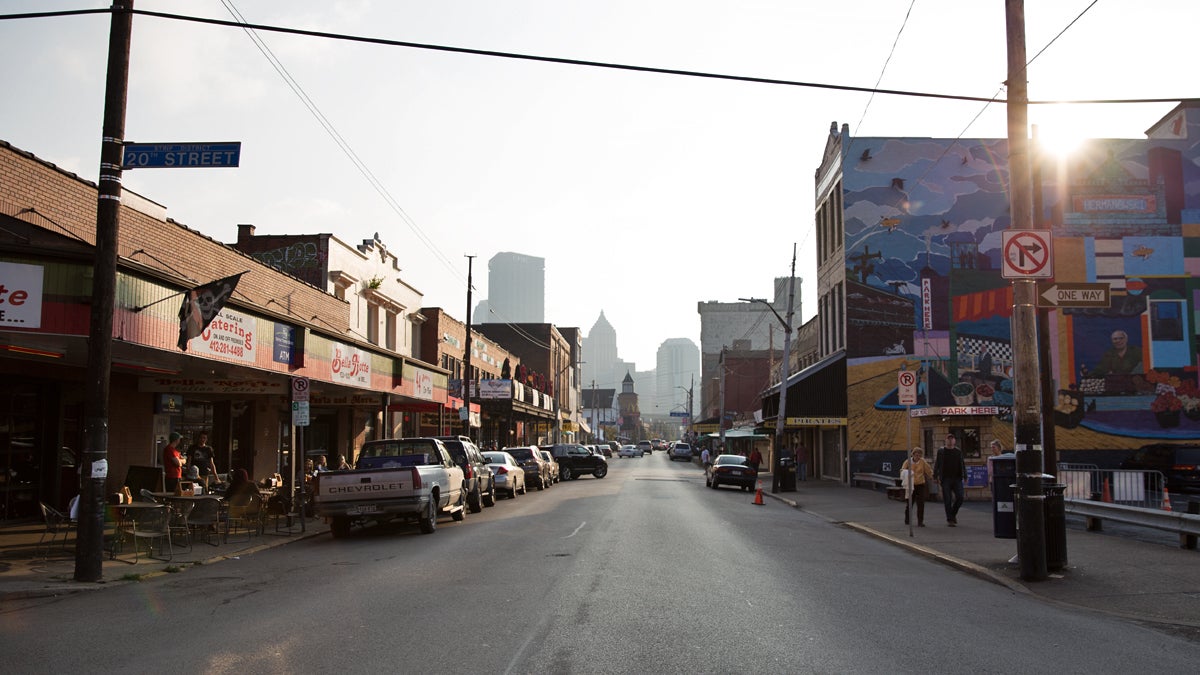Film insiders worry about Western Pennsylvania losing role in industry

Pittsburgh Strip District neighborhood, home to 31st Street Studios. (Lindsay Lazarski/WHYY)
Western Pennsylvania’s film industry is having growing pains. It just wrapped up a blockbuster year that included the simultaneous filming of two major motion pictures — a first for Pittsburgh.
Western Pennsylvania’s film industry is having growing pains. It just wrapped up a blockbuster year that included the simultaneous filming of two major motion pictures — a first for Pittsburgh. A new studio opened in Robinson, another plans to expand in McKees Rocks and the region is vying for a record 15 film and TV projects this year.
“We have more productions than places to put them,” said Dawn Keezer, director of the nonprofit Pittsburgh Film Office.
Keezer and others who play a supporting role in the local industry are concerned that Pennsylvania’s film tax credit program — capped at $60 million — cannot support growth or woo more productions. They are calling on Gov.-elect Tom Wolf to expand the program to promote local jobs.
Critics call the tax break unfair.
“The government shouldn’t be in the business of helping some businesses over others. It makes more sense to lower the tax rate for all businesses, as Pennsylvania has the second-highest corporate tax rate in the nation,” said Cindy Hamill-Dahlgreen, spokeswoman for the Commonwealth Foundation, a free-market policy group in Harrisburg.
The state program provides a tax credit of as much as 25 percent of a filmmaker’s production budget, provided that at least 60 percent of that budget is spent in Pennsylvania. Productions using studios in Pennsylvania that meet certain criteria are eligible for an additional 5 percent credit.
Pennsylvania has eight such studios, known as “qualified production facilities.” They include 31st Street Studios in the Strip District; Island Studios in McKees Rocks; WQED Multimedia in Oakland; and Pittsburgh Studios in Churchill. Others are in Delaware County, Philadelphia and Chester County.
Cyndi Casteel recently opened studio space inside a 120,000-square-foot Robinson warehouse and has applied for similar status.
“The resources are finite. The pie can only be cut up so many times,” said Chris Breakwell, founder of 31st Street Studios in the Strip District, where filming last year included two major motion pictures, “The Last Witch Hunter,” starring Vin Diesel, and a Will Smith film with the working title “Concussion.”
From the tax program’s inception in 2004 through the end of the 2014 fiscal year in June, the state approved or awarded $433.5 million in film tax credits for a combined 355 film productions, Department of Community and Economic Development records show. The program started out by giving $10 million a year, then increased to a high of $75 million a year before falling to $42 million a year under former Gov. Ed Rendell. Outgoing Gov. Tom Corbett set the budget at $60 million.
The DCED said the tax credits leveraged nearly $1.8 billion in production costs, from those related to filming to money spent on food and lodging, wardrobe and facility rentals. Much of the money goes to local businesses that support the film industry, Keezer said.
Keezer would like the available credits to be “uncapped.” She’s optimistic that the change in the governor’s mansion could result in at least an expansion of the program, despite the state’s dire financial picture that includes a projected $2 billion budget deficit.
A spokesman for Wolf, who is to be inaugurated Jan. 20, did not comment specifically on the film tax credit program.
“As he learns more about the depth of the budget deficit that will confront his administration, (Wolf) will thoroughly review spending programs,” said spokesman Jeff Sheridan.
Antony Davies, an economics professor at Duquesne University and critic of the tax credit, cited a 2013 report by Pennsylvania’s Independent Fiscal Office that said the state would receive 14 cents in tax revenue for every dollar it granted in tax credits. That report predicted that DCED would authorize $120 million to $180 million in annual credits if the program were uncapped — meaning, according to the fiscal office’s math, that the credits would generate about $25.2 million in tax revenue for the state.
The film tax credit program “is Harrisburg forcing Pennsylvanians to invest their money in an industry that (the Independent Fiscal Office) has said is a poor investment,” Davies said.
Keezer said the credits are “not about returning taxes to Harrisburg. It’s about generating money into the economy and supporting local and small businesses” that support the film industry.
State Sen. Wayne Fontana, D-Brookline, a longtime booster of the film tax credit program, said he intends to introduce legislation this year to raise the annual cap to $150 million. A 2013 bill he co-sponsored to raise the cap to $100 million did not make it out of the Finance Committee.
“The film industry is an asset in so many ways, and it gives the economy a boost,” Fontana said.
Chip Eccles, business representative for the International Alliance of Theatrical Stage Employees’ Studio Mechanics Local 489, said credits dry up in the first half of the fiscal year.
“We’re busy now, but it’s cyclical. When the credits dry up, people stop working,” Eccles said recently at 31st Street Studios where carpenters, painters and other workers were busy making “Concussion” sets that include a Florida condominium and space in the old Allegheny County Coroner’s Office. “Expanding the program would keep people working year-round.”
—
This report is from Tom Fontaine of the Pittsburgh Tribune-Review, via Associated Press member exchange.
WHYY is your source for fact-based, in-depth journalism and information. As a nonprofit organization, we rely on financial support from readers like you. Please give today.




